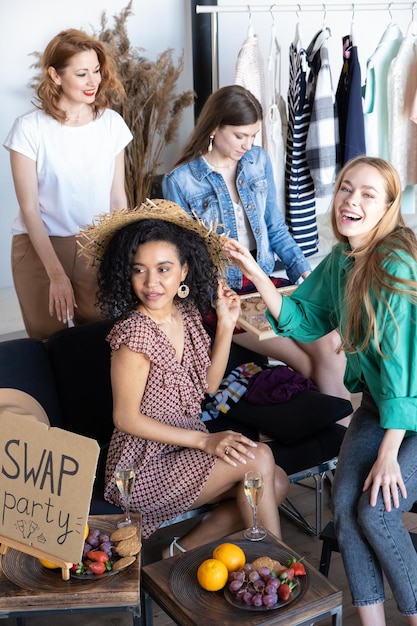Sustainable Style on a Shoestring: Affordable Fashion Updates for Under $100

Updating your wardrobe sustainably doesn’t have to break the bank; there are several creative and affordable ways to refresh your style for less than $100, including thrifting, upcycling, swapping clothes, and choosing versatile pieces.
Want to refresh your look without emptying your wallet or harming the planet? Discover how to achieve sustainable fashion on a budget: 7 ways to update your wardrobe for less than $100, making conscious style choices accessible to everyone.
Embrace the Thrifting Revolution
Thrifting, or shopping at secondhand stores, is a fantastic way to find unique and affordable clothing items while reducing textile waste. It offers the thrill of the hunt and the satisfaction of giving pre-loved garments a new life.
Why is Thrifting Sustainable?
Each item you purchase from a thrift store is one less item contributing to the demand for new manufacturing, which consumes vast amounts of water, energy, and raw materials. It also helps divert clothing from landfills, where textiles can take decades to decompose.
Tips for Successful Thrifting
To make the most of your thrifting experience, consider these tips:
- Go Regularly: Thrift stores receive new donations daily, so frequent visits increase your chances of finding hidden gems.
- Be Patient: Thrifting requires time and patience. Don’t get discouraged if you don’t find something immediately.
- Inspect Carefully: Check items for stains, tears, and other damage before purchasing.
By embracing thrifting, you are not only saving money but also actively participating in a more sustainable fashion cycle. You can find designer and great pieces that are in perfect conditions!

Upcycle and Reimagine Your Existing Wardrobe
Before heading to the stores, take a good look at what you already own. Upcycling involves transforming old or unwanted clothing items into something new and stylish.
Simple Upcycling Ideas
There are numerous ways to upcycle your clothes, even without advanced sewing skills:
- Crop Tops: Turn an old t-shirt into a trendy crop top by simply cutting it to your desired length.
- Patches and Embroidery: Add patches or embroidery to cover stains or holes, or to personalize your garments.
- Dyeing: Revive faded or discolored clothing with fabric dye.
More Advanced Upcycling Projects
If you’re feeling more ambitious, try these projects:
- Jeans to Shorts: Cut off the legs of old jeans to create a pair of shorts.
- Dress from a Shirt: Use an oversized shirt to create a dress.
- Bag from Jeans: Use some extra jeans to create a stylist bag to go shopping or go out with your friends.
Upcycling not only extends the life of your clothes but also allows you to express your creativity and create truly unique pieces.
Host a Clothing Swap with Friends
Organizing a clothing swap with friends is a fun and sustainable way to refresh your wardrobe without spending any money. It allows you to exchange clothes you no longer wear for items that someone else is willing to part with.
How to Organize a Successful Clothing Swap
Here are some tips to make your clothing swap a success:
- Set the Rules: Establish guidelines for the type and quality of clothing accepted.
- Invite a Diverse Group: Invite friends with different styles and sizes to ensure a variety of options.
- Create a Fun Atmosphere: Provide snacks, drinks, and music to make the event enjoyable.
Benefits of Clothing Swaps
Clothing swaps offer numerous benefits:
- Sustainable: They promote reuse and reduce textile waste.
- Affordable: They provide a free way to update your wardrobe.
- Social: They are a fun way to connect with friends.
By participating in clothing swaps, you can discover new styles and give your old clothes a new home.

Rent Clothing for Special Occasions
Instead of buying a new outfit for every special occasion, consider renting clothing. Rental services offer a wide variety of designer and high-end garments at a fraction of the retail price.
Benefits of Renting
Renting offers several advantages:
- Cost-Effective: It saves you money compared to buying new clothes.
- Sustainable: It reduces textile waste by maximizing the use of each garment.
- Variety: It allows you to try different styles and brands without committing to a purchase.
Popular Rental Services
Several rental services are available online:
- Rent the Runway: Offers a wide selection of designer clothing and accessories.
- Nuuly: Allows you to rent six items per month.
- Style Lend: Lets you borrow clothes from other users’ closets.
Renting is a great option for special events or occasions where you want to make a statement without breaking the bank or contributing to fast fashion.
Choose Versatile Pieces That Can Be Styled in Multiple Ways
Investing in versatile pieces that can be styled in multiple ways is a smart way to maximize your wardrobe and reduce the need for constant new purchases. These are clothes that can be matched no matter what. Clothes that can be combined and still look elegant and chic.
Examples of Versatile Pieces
Some examples of versatile pieces include:
- Little Black Dress: Can be dressed up with heels and jewelry or dressed down with flats and a denim jacket.
- White Button-Down Shirt: Can be worn as a top, layered under sweaters, or tied around the waist.
- Neutral Cardigan: Can be paired with dresses, skirts, or pants for added warmth and style.
Tips for Styling Versatile Pieces
To get the most out of your versatile pieces, consider these tips:
- Experiment with Accessories: Use different accessories to change the look of your outfit.
- Layering: Layer your versatile pieces to create different textures and silhouettes.
- Mix and Match: Don’t be afraid to mix and match your versatile pieces with other items in your wardrobe.
By choosing versatile pieces, you can create a variety of outfits with a minimal number of garments.
Repair and Maintain Your Clothes Properly
extending the life of your clothes through proper repair and maintenance is crucial for long-term sustainability. Learning basic sewing skills and taking care of your garments can significantly reduce the need for frequent replacements.
Basic Repair Skills
Some essential repair skills include:
- Sewing Buttons: Learning how to sew buttons back on your clothes is a simple but valuable skill.
- Mending Seams: Repairing ripped seams can prevent further damage to your garments.
- Patching Holes: Patching holes in your clothes can give them a new lease on life.
Proper Maintenance Techniques
Proper maintenance techniques include:
- Washing Clothes Properly: Follow the care instructions on the garment label to avoid shrinking, fading, or damage.
- Storing Clothes Correctly: Store your clothes in a cool, dry place to prevent mold, mildew, and insect damage.
- Ironing or Steaming: Ironing or steaming your clothes can help remove wrinkles and keep them looking their best.
By investing time in repairing and maintaining your clothes, you are not only saving money but also reducing textile waste.
Shop from brands with sustainable practices
While it’s already tough to live sustainably, you might as well buy from sustainable businesses and manufacturers and support the growth of sustainable fashion in order to promote ethical and lasting fashion.
Researching Brands
Knowing which brands meet the bar involves looking at their materials, suppliers, workers, and environmental effect. Certification such as the Fair Trade, B Corp, and Global Organic Textile Standard (GOTS for short) all support this.
Being an informed consumer
You can promote sustainability in fashion by shopping in a way that takes these aspects into account. Every purchase decision matters: ask yourself whether a garment meets your needs, is produced in moral and environmental ways, and will last your wardrobe for a very long time.
| Key Point | Brief Description |
|---|---|
| ♻️ Thrifting | Shop secondhand stores for unique, affordable items. |
| 🧵 Upcycling | Transform old clothes into new stylish pieces. |
| 🤝 Clothing Swaps | Exchange clothes with friends for free wardrobe updates. |
| 👗 Renting | Rent clothes for special occasions instead of buying new. |
FAQ Section
What are some easy ways to start incorporating sustainable fashion into my daily life?
▼
Start by making small changes, such as thrifting, upcycling old clothes, and choosing versatile pieces that can be styled in multiple ways. Every little action counts towards a more sustainable wardrobe.
How can I tell if a brand is truly sustainable?
▼
Look for brands that are transparent about their supply chain, use eco-friendly materials, and have certifications like Fair Trade or GOTS. Check reviews and look for detailed information.
Is sustainable fashion more expensive than fast fashion?
▼
Sustainable fashion can sometimes be more expensive upfront, but it is often more durable and long-lasting, making it a better investment in the long run. Thrifting and upcycling are also very cheap.
What are some eco-friendly materials I should look for when shopping?
▼
Look for materials like organic cotton, recycled polyester, hemp, and Tencel. These materials have a lower environmental impact compared to conventional options.
How can I properly dispose of old clothing that I no longer want?
▼
Donate clothes, or see if it can be repurposed. Don’t throw it away because clothing left in landfill damages the enviroment. If it can’t be done with, look to recycle it.
Conclusion
Achieving sustainable fashion on a budget is not only possible but also a rewarding journey. By embracing thrifting, upcycling, clothing swaps, and mindful shopping habits, you can create a stylish and eco-friendly wardrobe without breaking the bank. Remember, every small step towards sustainability makes a big difference for the planet and your wallet.
